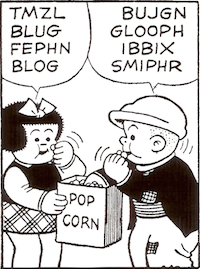
[Peanuts, January 8, 1967, reappearing as today’s strip. The pink background is well chosen.]
Lucy has made a piece of toast for her brother and has extracted from him ever more fulsome expressions of gratitude: “Thank you, dear sister.” “Thank you, dear sister . . greatest of all sisters.” “Thank you, dear sister, greatest of all sisters, without whom I’d never survive!” If anyone in the comics is going to observe a distinction between nauseated and nauseous, it would be Linus van Pelt.
I learned about this distinction — if it is one — from David Foster Wallace: “Nauseous for nauseated” is one entry in the page-long catalogue of bad usage that prefaces Wallace’s essay “Tense Present.” In Infinite Jest, Kate Gompert speaks of feeling nauseous. Her doctor refers to feeling nauseated. The novel’s third-person narrator also distinguishes between the words.
This distinction — if it is one — has a long history for snoots and sticklers. There’s no entry for it in the original Fowler’s. Nor is there one in the 1959 edition of The Elements of Style. But Theodore Bernstein’s The Careful Writer (1965) has it:
A thing is nauseous if it makes one sick to the stomach; the unfortunate victim of this malaise is nauseated. The common misuse of nauseous appears in this passage: “When he sits too long, turns his head too abruptly, or walks any distance, he gets dizzy, loses balance, and becomes nauseous.” He doesn’t become nauseous unless he turns other people’s stomachs; he becomes nauseated. A person who feel sick is no more nauseous than a person who has been poisoned is poisonous.
Wilson Follett’s
Modern American Usage (1967) makes a brief mention:
When, for example, we have two adjectives, nauseous and nauseated, it should be clear that the first applies to the substance that causes the state named in the second. To call oneself nauseous except in self-depreciation is to ignore the point of view of the word.
I wonder: could the language of advertising have prompted attention to these words? Were people in mid-’60s Pepto-Bismol commercials proclaiming themselves to be nauseous? I have a vague memory of such commercials — “I . . . feel . . . nauseous.” Or was it “I . . . feel . . . awful”? Did such commercials precede these books? I don’t know.
E. B. White caught up in the third (1979) edition of
The Elements of Style:
Nauseous. Nauseated. The first means “sickening to contemplate”; the second means “sick at the stomach.” Do not, therefore, say, “I feel nauseous,” unless you are sure you have that effect on others.
And
Garner’s Modern American Usage (2009) says that the use of
nauseous for
nauseated
is becoming so common that to call it an error is to exaggerate. Even so, careful writers tend to be sickened by the slippage and to follow the traditional distinction in formal writing: what is nauseous makes one feel nauseated.
And examples of careful use follow, the first of which comes from — yes, from David Foster Wallace. In Bryan Garner’s Language-Change Index,
nauseous for
nauseated is at Stage 4, meaning that use is “virtually universal but is opposed on cogent grounds by a few linguistic stalwarts (die-hard snoots).”
The repeated
if it is one in this post signals my skepticism about this distinction. There are many
-ous words that can describe people (
cantankerous,
flirtatious,
generous,
outrageous);
nauseous is easily at home among them. And we do have
nauseating to describe whatever makes one nauseous.
The curious thing, which I find in no discussion of this distinction: the
Oxford English Dictionary has this earliest (now obsolete) meaning for
nauseous (1613): “Of a person, the stomach, etc.: inclined to sickness or nausea; squeamish.” Look at that: the word first described people. And according to the
OED,
nauseous in American usage has applied to people since 1885: “affected with nausea; having an unsettled stomach; (
fig .) disgusted, affected with distaste or loathing.” That makes the
nauseated/
nauseous distinction — if it is one — look tenuous indeed. There are other matters of usage more deserving of attention. Some of them have me climbing the walls. Literally!
This post is an instance of what can happen when I read the comics.
[“Thank you, dear sister . . greatest of all sisters”: not a typo. Just as many a cartoon hand has only four fingers, a cartoon ellipsis may have only two dots. The first edition of the
OED gives the earliest meaning of
nauseous as “inclined to nausea; fastidious” and does not address American usage.]
























